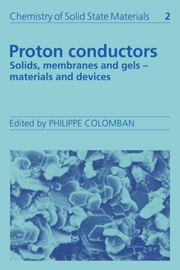Book contents
- Frontmatter
- Contents
- List of contributors
- Preface
- Symbols
- I HYDROGEN BOND AND PROTONIC SPECIES
- II MATERIALS: PREPARATION, STRUCTURES AND PROPERTIES
- 7 Structure and characterization of hydrogen insertion compounds of metal oxides
- 8 High temperature proton conductors based on perovskite-type oxides
- 9 Highly ionic hydroxides: unexpected proton conductivity in Mg(OH)2 and homologues
- 10 Ice
- 11 Anhydrous materials: oxonium perchlorate, acid phosphates, arsenates, sulphates and selenates
- 12 Hydrogen behaviour in graphite–nitric acid intercalation compounds
- 13 Proton-containing β- and β″-alumina structure type compounds
- 14 Proton conduction in zeolites
- 15 Proton containing NASICON phases
- 16 Phosphates and phosphonates of tetravalent metals as protonic conductors
- 17 Hydrogen uranyl phosphate, H3OUO4PO4. 3H2O (HUP), and related materials
- 18 From crystalline to amorphous (particle) hydrates: inorganic polymers, glasses, clays, gels and porous media
- 19 Perfluorinated membranes
- 20 Mixed inorganic-organic systems: the acid/polymer blends
- III PROTON DYNAMICS AND CHARGE TRANSPORT
- IV PROTON DIFFUSION MECHANISMS
- V DEVICES
- Index
16 - Phosphates and phosphonates of tetravalent metals as protonic conductors
Published online by Cambridge University Press: 04 May 2010
- Frontmatter
- Contents
- List of contributors
- Preface
- Symbols
- I HYDROGEN BOND AND PROTONIC SPECIES
- II MATERIALS: PREPARATION, STRUCTURES AND PROPERTIES
- 7 Structure and characterization of hydrogen insertion compounds of metal oxides
- 8 High temperature proton conductors based on perovskite-type oxides
- 9 Highly ionic hydroxides: unexpected proton conductivity in Mg(OH)2 and homologues
- 10 Ice
- 11 Anhydrous materials: oxonium perchlorate, acid phosphates, arsenates, sulphates and selenates
- 12 Hydrogen behaviour in graphite–nitric acid intercalation compounds
- 13 Proton-containing β- and β″-alumina structure type compounds
- 14 Proton conduction in zeolites
- 15 Proton containing NASICON phases
- 16 Phosphates and phosphonates of tetravalent metals as protonic conductors
- 17 Hydrogen uranyl phosphate, H3OUO4PO4. 3H2O (HUP), and related materials
- 18 From crystalline to amorphous (particle) hydrates: inorganic polymers, glasses, clays, gels and porous media
- 19 Perfluorinated membranes
- 20 Mixed inorganic-organic systems: the acid/polymer blends
- III PROTON DYNAMICS AND CHARGE TRANSPORT
- IV PROTON DIFFUSION MECHANISMS
- V DEVICES
- Index
Summary
Introduction
For many years it has been known that amorphous precipitates having a composition of M(IV)(HPO4)2–x(OH)2x.nH2O (x usually ranging from 0 to 0.4) are easily formed when a salt solution of a tetravalent metal (M(IV) = Zr, Ti, Ce, Th, Sn etc.) is mixed with a phosphoric or arsenic acid solution. Due to their peculiar properties (high ion exchange capacity, thermal stability, insolubility in concentrated acids, resistance to radiation, selectivity for some cations of interest in nuclear energy etc.) these amorphous precipitates were intensely investigated between 1954–1964 especially in nuclear centres. During this period Hamlen and Alberti also discovered that amorphous zirconium phosphate exhibits a good protonic transport at room temperature (0.1–6 x 10–3 Ω–1 cm–1).
After 1964, the discovery that layered crystalline compounds (general formula M(IV)(HO—PO3)2.H2O) can be obtained by refluxing amorphous materials or prepared directly by slow precipitation in the presence of HF gave rise to an increased interest in these inorganic ion-exchangers.
It was found that a tetravalent metal can be bonded to the oxygens belonging to XO4 and/or R—XO3 groups (X = P, As; R = inorganic or organic radical such as —H, —OH, —CH3OH, —C6H5 etc.) forming two different layered structures usually called α and γ. Some fibrous structures (e.g. cerium and thorium phosphates) or tridimensional structures (e.g. HZr2(PO4)3 and Zr(R(PO3)2) can also be obtained.
- Type
- Chapter
- Information
- Proton ConductorsSolids, Membranes and Gels - Materials and Devices, pp. 238 - 253Publisher: Cambridge University PressPrint publication year: 1992
- 9
- Cited by



